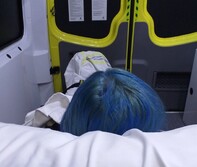Mary's Story
Mary* was only 14 years old when she started feeling really nauseous all the time. The urge to throw up in class was getting in the way of her wanting to be at school.
Mary’s mum Rachel took her to the doctor and shared her symptoms. Mary was prescribed anxiety medication which helped with nausea for a little bit, but symptoms returned. Their GP consulted a pediatrician who suggested treating for constipation and multiple blood and stool tests were done with no results. One of the tests requested by the GP was an Helicobacter pylori (H pylori) test however the lab said that instances of H pylori in under 18 year olds was rare, so the test was not carried out.
Mary’s symptoms continued in severity, they included:
nausea exacerbated which became worse when hungry, causing extreme pain
waking in the night to vomit or dry retch 2-3 times a week
horrendous pain (shaking, pale, doubled over) at least 3 times a week.
bouts of extreme constipation
At times, the symptoms were so severe Mary’s parents called an ambulance and there were trips to the Emergency Department.
To get some answers, Rachel had booked a private ultrasound appointment and then a gastroenterologist. Unfortunately the gastroenterologist missed the fact that the H.plyori test was declined however it was eventually found during an endoscopy.
Once H.pylori is found, it can be eradicated with a course of antibiotics (a combination of two antibiotics and a protein pump inhibitor such as omaprozle is required due to the bacteria’s antibiotic resistance).
H. pylori is a bacteria that can be found in your stomach. The infection does not go away naturally, but most people never develop symptoms. H. pylori, a group 1 carcinogen, causes nearly 90% of non-cardia gastric cancers, with the lifetime risk of developing gastric cancer of approximately 3 percent in those infected. Māori and Pacific people have a higher prevalence of H. pylori infection when compared with NZ Europeans, as well as Māori and Pasifika being infected with a more carcinogenic strain. These ethnic differences in H. pylori are the predominant reason for the inequities that exist in gastric cancer rates and deaths between Māori and NZ European in Aotearoa.
Identifying and treating H. pylori can prevent the development of stomach cancer especially in high risk groups. Symptoms to look our for are:
upper abdominal pain
heartburn
bloating
nausea or vomiting
poor appetite
feeling full after a small meal.
Some warning signs that you need to see a doctor urgently include:
vomiting blood
sudden weight loss
difficulty swallowing
vomiting
a family history of stomach cancer
symptoms of anaemia such as light-headedness.
Unfortunately, the journey to diagnosis was not simple for Mary and has caused some health anxiety. Rachel wants others to be clear on the symptoms of an H.pylori infection so a test can be advocated for.
Rachel says “Those clues about nausea and hunger, as well as the night waking I think are important irrespective of what statistics tell us is the most likely cause, all avenues should be investigated."
